
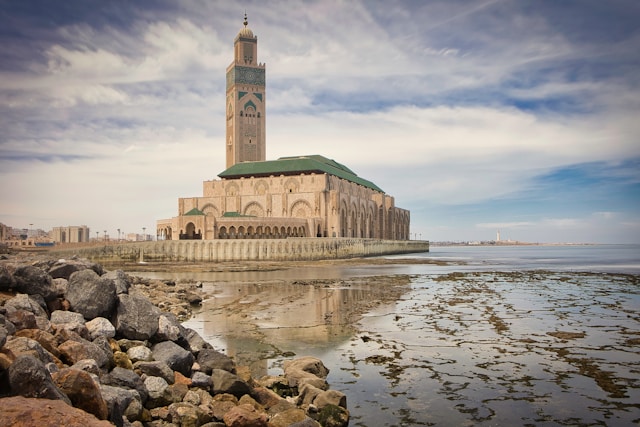
Standing proudly on the edge of the Atlantic Ocean, the Hassan II Mosque Museum is more than a place of worship — it’s a symbol of Moroccan identity, artistry, and devotion. This iconic landmark in Casablanca, the country’s largest city, draws millions of visitors each year who come to admire its breathtaking architecture, intricate craftsmanship, and deep spiritual meaning.
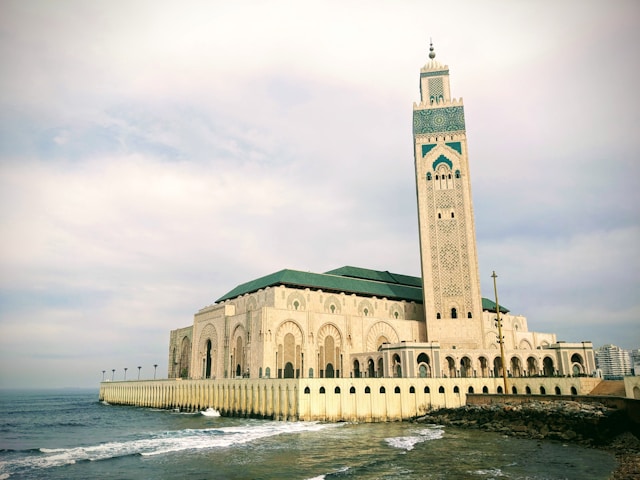
The mosque’s museum, often overlooked by casual visitors, offers an intimate glimpse into the genius behind its creation — from hand-carved cedar ceilings to delicate zellij mosaics and marble columns. Exploring the Hassan II Mosque Museum is not just a tour of a building; it’s a journey through Morocco’s soul, where faith meets art and tradition embraces innovation.
The Majesty of the Hassan II Mosque
A Vision of Faith and Modernity
Commissioned by King Hassan II and completed in 1993, the Hassan II Mosque is one of the largest mosques in the world. It can accommodate more than 25,000 worshippers inside and an additional 80,000 in its courtyards. Rising above the city, its 210-meter (689 ft) minaret — the tallest in the world — stands as a beacon of faith visible from miles away.
Built partly over the sea, the mosque embodies a Quranic verse: “The throne of God was built upon the water.” This poetic symbolism, combined with extraordinary Moroccan craftsmanship, makes it one of the most awe-inspiring religious sites on Earth. Learn more about its history on Wikipedia: Hassan II Mosque.
Inside the Hassan II Mosque Museum
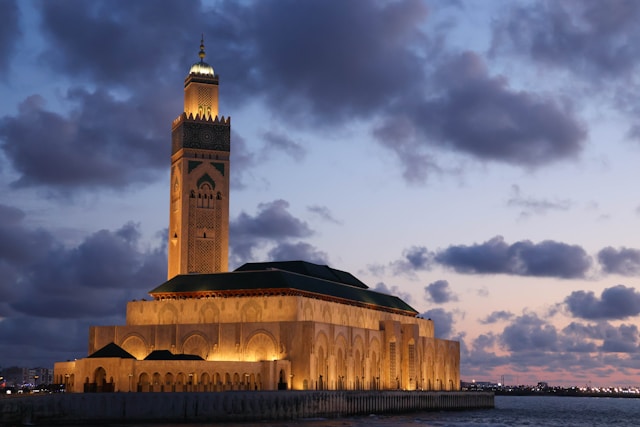
A Hidden Gem Beneath Grandeur
While the mosque’s grand prayer hall often steals the spotlight, the Hassan II Mosque Museum — located within the mosque complex — offers an equally mesmerizing experience. It showcases the artistry, tools, and techniques used by Morocco’s finest craftsmen (maalems) who built this architectural masterpiece.
The museum’s collection includes:
- Intricately carved wood panels from cedar and mahogany.
- Zellij tiles and plaster molds used in the mosque’s ornamentation.
- Scale models and architectural plans illustrating the mosque’s construction process.
- Photographs and videos documenting the 6-year effort that brought over 10,000 artisans together.
Every exhibit celebrates Morocco’s legacy of design and devotion. The museum tells the story of collaboration — between traditional artisans and modern engineers — who created harmony between the old and the new.
Must-See Highlights and Experiences
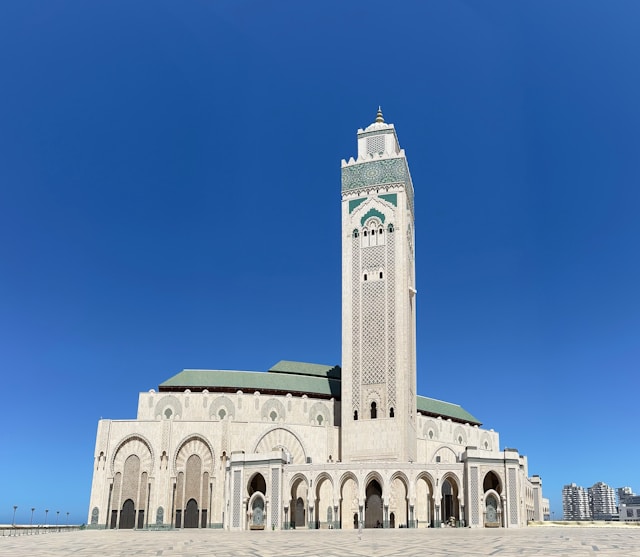
1. The Grand Prayer Hall
The prayer hall is the heart of the mosque — an immense space covering 20,000 square meters. Its retractable roof allows sunlight and sea breeze to flood in, connecting the worshippers to nature. The chandeliers, made from Venetian glass, illuminate hand-carved marble and wood in patterns that reflect Islamic geometry and Moroccan artistry.
2. The Glass Floor Over the Atlantic
Few experiences are as breathtaking as standing on the mosque’s glass floor and gazing down at the waves beneath. It’s a literal meeting of faith and the sea — a moment where spirituality and nature unite.
3. The Museum Gallery
Inside the Hassan II Mosque Museum, visitors can see how the mosque came to life. Each artifact, from blueprints to chisels, tells the story of dedication. The museum highlights not just finished works of art but also the process — an important tribute to Moroccan craftsmanship.
4. The Hammam (Bath House)
Though not yet in public use, the underground hammam beneath the mosque showcases traditional Moroccan bath architecture, with white marble columns and star-shaped basins. It’s a beautiful example of how the mosque integrates cultural elements beyond worship.
Travel Tips and Cultural Insights
Visiting the Hassan II Mosque Museum is an unforgettable experience, especially when approached with respect and curiosity.
Guided Tours
Non-Muslim visitors can enter the mosque and museum only with guided tours, available in several languages (including English, French, and Arabic). These tours run multiple times a day and last about 45 minutes.
Dress Code
Visitors should dress modestly — covering shoulders, arms, and legs — out of respect for the sacred space. Shoes must be removed before entering prayer areas.
Best Time to Visit
Morning and late afternoon are ideal, when the sunlight enhances the beauty of the mosaics and marble. Try to visit during weekday mornings for fewer crowds.
Photography
Photography is allowed in most areas, but avoid flash inside the prayer hall. The museum also has stunning angles for capturing details of Moroccan craftsmanship.
Real Stories from Travelers
Many visitors describe their visit to the Hassan II Mosque Museum as deeply emotional.
“It’s not just a mosque — it’s a masterpiece. The museum gave me a new appreciation for Moroccan artisans,” wrote a traveler from Spain.
“Standing by the ocean, hearing the call to prayer echo through Casablanca — it’s one of the most peaceful moments of my life,” shared another from Canada.
Others say that the museum’s displays made them realize how every tiny tile and carving had meaning — a reminder that beauty often lies in patience and devotion.
Future Travel Recommendations and Seasonal Insights
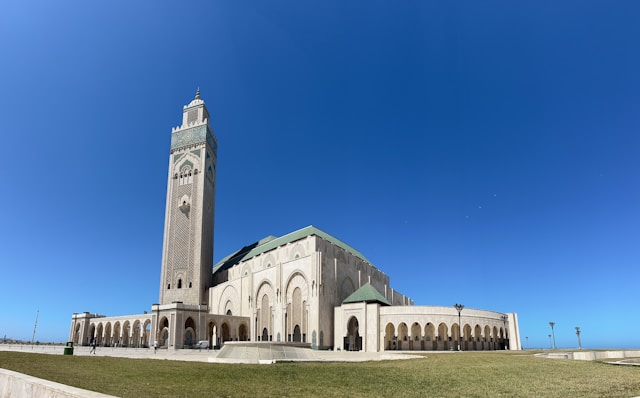
As Casablanca continues to grow as a major tourist destination, the Hassan II Mosque Museum remains a cornerstone of Moroccan cultural tourism.
New Developments
Plans are underway to expand cultural facilities around the mosque, including educational programs for art students and exhibitions highlighting Moroccan Islamic architecture.
Seasonal Visits
- Spring (March–May): Ideal for mild weather and clear skies.
- Autumn (September–November): Perfect for photography and fewer crowds.
- Ramadan: While non-Muslim visitors can’t enter the mosque during prayers, the atmosphere around the mosque is magical — with lanterns, music, and families gathering after sunset.
Combining Your Visit
After exploring the Hassan II Mosque Museum, take a short walk to the Corniche of Casablanca, a scenic seaside promenade filled with cafes and ocean views. Learn more about the city’s culture and history on Wikipedia: Casablanca.
FAQ – Hassan II Mosque Museum
1. Can non-Muslims visit the Hassan II Mosque Museum?
Yes. Non-Muslims are welcome to visit the mosque and museum through guided tours, which are organized several times daily.
2. How long does it take to explore the mosque and museum?
Plan around 1.5 to 2 hours to fully appreciate both the mosque’s main prayer hall and the museum exhibits.
3. Is photography allowed inside the mosque and museum?
Yes, photography is permitted, but flash and tripods are discouraged inside the prayer hall.
4. What makes the Hassan II Mosque Museum unique?
It showcases the artistry behind Morocco’s most iconic structure — from the tools artisans used to the designs that inspired the mosque’s geometric harmony.
5. How can I get there?
The mosque is easily accessible from downtown Casablanca. You can take a taxi, tram, or even walk from the Corniche area — the mosque is a landmark visible from afar.
Conclusion
The Hassan II Mosque Museum is a celebration of Morocco’s creative spirit, faith, and craftsmanship. Whether you’re an architecture lover, an art enthusiast, or simply a traveler seeking beauty and serenity, this place offers an unforgettable experience.
As waves crash beneath its glass floor and the call to prayer echoes over the Atlantic, you’ll understand why the Hassan II Mosque Museum is more than a monument — it’s a living masterpiece that bridges heaven and earth.




